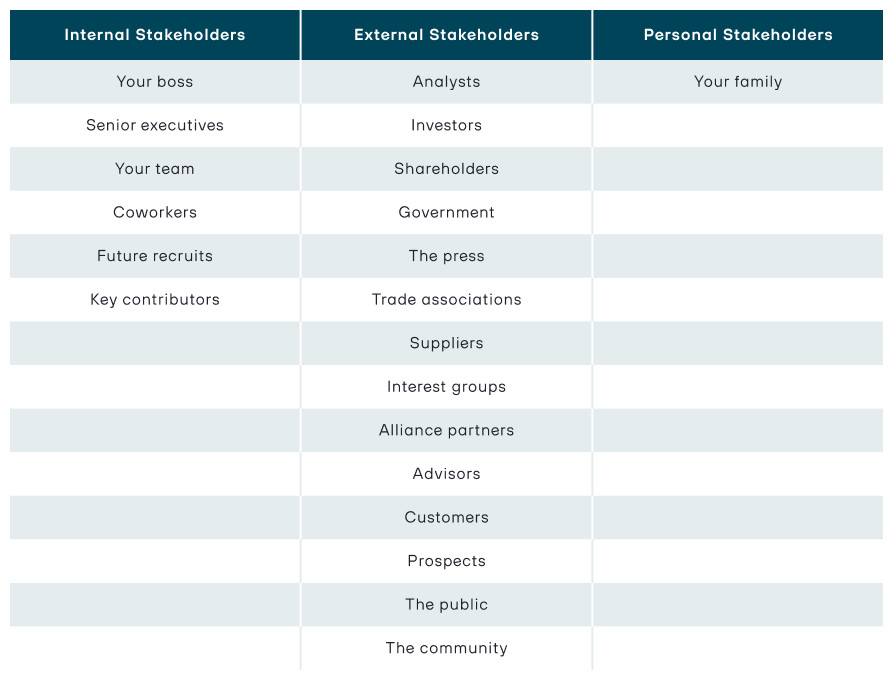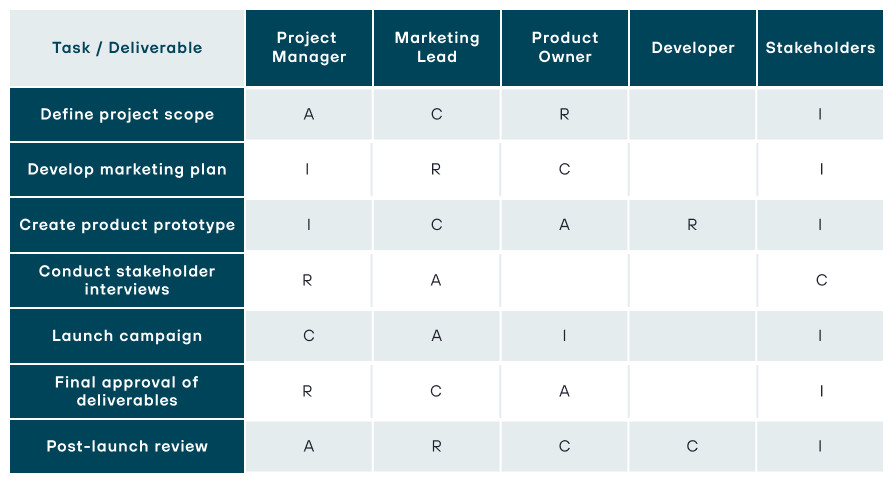How to build a digital business case that wins support
A practical guide to align priorities, build a value-driven business case, and keep it real with stakeholders who might not speak “digital.”
Managing stakeholder expectations
Whether you’re running a project, rolling out a new platform, embarking on a digital experience transformation, or trying to change how things are done, managing different stakeholders is a tricky yet important aspect of the job. Projects with structured stakeholder engagement succeed 83% of the time, compared to just 32% without it.
What’s a stakeholder, really?
A stakeholder is anyone who has a vested interest in what you’re doing. That might mean they’ll be directly impacted by your project, such as a new digital customer journey, putting money behind it, or having the authority to influence the outcome. Stakeholders can be internal - like department heads, senior leadership, or your own team - or external, such as clients, partners, government bodies, regulators, or even the public.
If your work affects them, or if they can affect your work, they’re a stakeholder. It’s that simple. And that's important.
Why stakeholders matter
Even with the best plan and a capable team, if your stakeholders aren't with you, the wheels start to wobble and progress stalls. End users, customers, or executives - all of them are stakeholders. If you don’t understand and involve them, you risk building something nobody wants or uses.
As stakeholders' expectations change, so should their view of digital
Stakeholders' expectations can be influenced by a number of factors - often, they’re reacting to real concerns, pressures, or poor past experiences. Some might feel out of the loop and frustrated. Others might be facing conflicting goals, shifting priorities, or even fear that your project will make their lives harder.
For these reasons, getting stakeholders on board for significant investments like a new digital experience often comes down to presenting a clear, compelling business case. If you're finding it tough to build that case and get the necessary buy-in, it's time to shift your approach and clearly demonstrate the value you'll deliver.
How true can help you:
Position technology as a strategic enabler:
This isn't just about new tools. We'll show how your digital investment enhances your ability to outcompete the market and better serve customers, directly linking it to your existing business goals.
-
We'll help you identify key metrics and the uplift you're aiming for.
-
These will be anchored in hard commercial data like revenue and profit, then flowing into specific digital marketing measures such as SEO traffic, conversion rates, or average order value.
Quantify the hidden costs of complexity and inaction:
We'll highlight the friction your existing tech stack creates in daily operations – whether it's publishing content, updating product pricing, or launching campaigns.
-
By estimating the time wasted on inefficient systems and attaching hard numbers to these tasks, we can reveal the significant opportunity to lower the cost of serving your customers and build an undeniable case for your investment.
Map out a phased, low-risk plan:
Digital transformation doesn't have to be an all-or-nothing leap.
-
We'll assist in breaking your vision into manageable phases with early wins – what matters most to your business right now? Focus on 1-2 key points to help get the project over the line. If you deliver on these points, future investment and buy-in will be much easier.
-
Starting with smaller, practical actions, like merging websites or using the same tech platform across the board, can help build trust and free up resources (like time, money, or people). These early wins show progress and help prove that steady momentum is just as important as having a big, long-term vision.
Get to know your stakeholders
You can’t manage what you don’t understand. Start by getting to know your stakeholders - what matters to them, the pressures they face, and how they like to work. When you show how a digital solution solves their real problems, you're far more likely to get their support.
Stakeholder types

Communicate like a human
People don’t connect with waffle, they connect with clarity. Whether it’s a stakeholder update, a project pitch, or just a quick meeting recap, keep it simple and straight.
If the work involves technical detail, break it down. Help people feel included, not left behind. Digital change can be daunting, but clear, accessible communication builds confidence and momentum for a project.
Set expectations early and be crystal clear
If you want fewer surprises, set things straight from the start. Make it clear what the project will deliver, when it will happen, and what you expect from them along the way. Spell out timelines, responsibilities, milestones, and decision points. When changes come up, and they will, communicate them early and clearly.
To better understand stakeholder motivations that come with digital change, consider asking yourself the following:
-
What are their top business priorities or challenges now?
-
What is the most effective way to communicate with them—email, meetings, reports, etc.?
-
What specific information or insights are they seeking?
-
Do they fully understand the scope and impact of your work, or do they require additional context or clarification?
-
Who are the key individuals who influence their decisions?
-
Who do they have influence over within the organisation?
-
What are their main areas of responsibility?
-
To whom do they report within the company structure?
Involve stakeholders smartly
People support what they help shape. That doesn’t necessarily mean visibility of the end-to-end process, but it does mean bringing the most relevant stakeholders in at the right times. Ask for input where it matters. Whether that’s design reviews of the latest digital wireframes, feedback from UX research, content sign-off, or sign off on key decisions. If you ask for feedback, be ready to show how you’ve acted on it. If you can’t accommodate it, explain why.
Find the common ground
Like all big projects, there are likely to be instances where priorities may differ, but if you can identify what you both want first, use this as the basis to structure delivery so you both get what you need.
When compromise is on the table, be upfront about trade-offs and explain the impact of choices clearly. If speeding up delivery means taking a calculated risk, or if adding extra features delays the deadline, say so – transparency is really key to the process.
Build trust
It sounds easy, doesn’t it – but being known for being reliable really holds its value in delivering complex digital solutions.
Delivering what you say you will, on time, every single time - even on small things will help to build internal confidence so that when things do go awry, honest conversations run a little smoother. Showing contributions, publicly or privately, also goes a long way to making colleagues feel part of the success of the project.
And finally, here are some tools that can help manage stakeholders
Forget bloated frameworks that sit on a shelf. Here are a few practical tools you can use right now to keep on top of your stakeholders, the same way we do:
Stakeholder map: Helps you understand who holds power and who’s most interested in your project. Plot stakeholders on a simple grid with one axis for influence and the other for interest. This lets you focus your time where it matters most - high influence, high interest stakeholders need more attention than those low in both.

RACI chart: Brilliant for clarifying roles. It spells out who’s Responsible, Accountable, Consulted, and Informed on key deliverables. This helps prevent the “I thought you were doing that” game and keeps everyone aligned.

Here are a few other useful ways to track and approach stakeholder relations.
-
Communication plan: Tailor this to each stakeholder’s preferences to save headaches. Some want weekly emails; others prefer quick calls or formal reports. Knowing this upfront helps you meet expectations without wasting time.
-
Issue and risk log: Use this to capture blockers, concerns, and risks in one shared place. Assign owners and track the progress of resolving them.
-
Feedback loop: Set up a way for stakeholders to raise concerns early and feel heard, whether that’s a shared document, a Slack channel, or regular meetings.
We all understand the importance of managing stakeholder interactions and their impact on project success, whether it be digital or organisational growth.
Through consistent application of strategies like building a value-driven business case, using appropriate supporting tools, and softer skills like effective compromise and transparent communication, organisations can build strong, positive stakeholder relationships that drive real change and progress.
If building a compelling business case for your digital experience is proving difficult, let's talk about how we can secure stakeholder buy-in. Drop Mike a line today.


